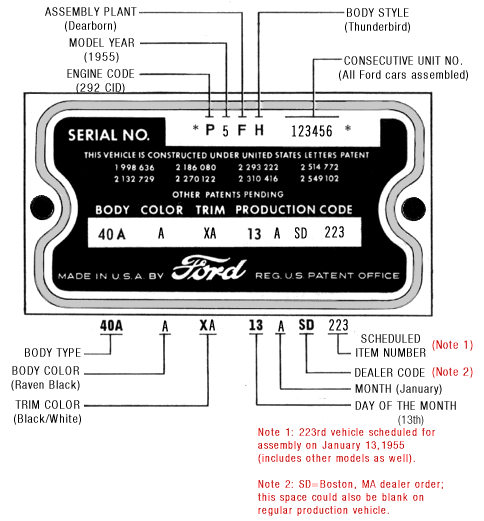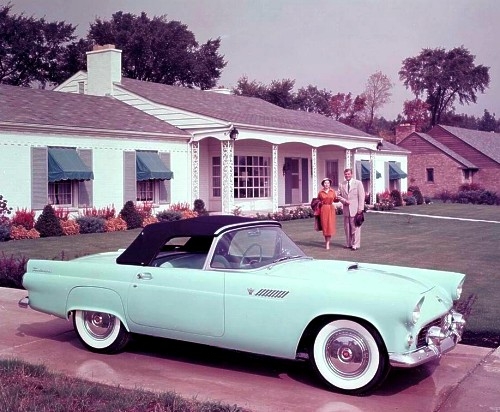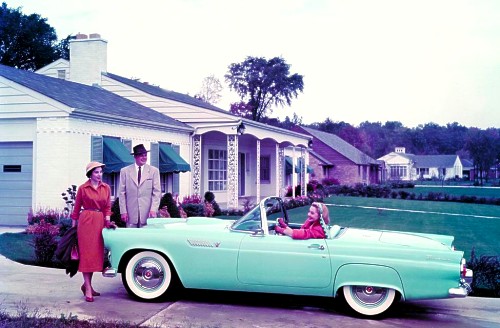| SPECIFICATIONS |
ENGINE CODE
|
ENGINE DETAILS
|
P |
Conventional or Overdrive Transmission:
Displacement: 292 CID
Bore and Stroke:3.75 x 3.30 in.
Compression Ratio: 8.1:1
Brake Horsepower: 193 @ 4400 rpm
Torque: 280 lbs.-ft. @ 2600 rpm
Carburetor: Holley four barrel
Ford-O-Matic Transmission:
Displacement: 292 CID
Bore and Stroke:3.75 x 3.30 in.
Compression Ratio: 8.50:1
Brake Horsepower: 198 @ 4400 rpm
Torque: 286 lbs.-ft. @ 2500 rpm
Carburetor: Holley four barrel |
TRANSMISSION CODE
|
TRANSMISSION DESCRIPTION
|
| -- |
Standard: 3-speed Synchromesh with helical gears
Ratios: 2.32:1 (first); 1.48:1 (second); 1:1 (third); 2.82:1 (reverse)
Optional Overdrive: Planetary overdrive with planetary gears
Ratio: 0.70:1
Cut-In Speed: 27 mph
Cut-Out Speed: 21 mph
Optional Automatic: Ford-O-Matic torque converter with planetary gears
Ratios: 1.48:1 (drive); 2.44:1 (low); 2.0:1 (reverse)
|
|
|
REAR AXLE CODE
|
REAR AXLE RATIO
|
| -- |
3.73:1 (standard/synchromesh)
4:10:1 (optional; standard synchromesh)
3.92:1 (standard/overdrive)
3.31:1 (Ford-O-Matic) |
|
|
TIRE SIZE |
BRAKES
|
6.70 x 15 4-ply BSW
Wheels: 5 inch
Original Brand: Firestone
Whitewall Width: 2 11/16" (optional)
|
Front: 11 inch hydraulic drum
Rear: 11 inch hydraulic drum
Total Swept Area: 175 sq. in. |
|
|
WHEELBASE
|
DIMENSIONS
|
102 inches
Front Tread: 56 inches
Rear Tread: 56 inches |
Length: 175.3 inches
Width: 70.3 inches
Height: 50.2 inches
Trunk:
Ground Clearance: 5.9 inches
Height to Top of Door: 34.2 inches
Height to Top of Hard Top: 52.2 inches
Front Leg Room: 45.4 inches
Front Shoulder Room: 53.3 inches
Front Hip Room: 58.8 inches
Front Headroom: 32.2 inches (Hardtop) |
| STEERING |
CAPACITIES
|
Turning Diameter: 36 ft.
Turns Lock-To-Lock: 3.5
Steering Ratio: 20.0:1
Steering Wheel Diameter: 17 inches |
Fuel Tank: --
Cooling System: 19 quarts |
| SPECIAL NOTES |
The 1955 Ford Thunderbird was the
world's first "personal" car. Not a sports car, not a luxury car, not a
compact car, not a family car, but a personal car. One that could be
tailored to the individual needs and desires of its owner.
In appearance, it was sporty, but it also was luxurious
with its pleated vinyl upholstery and upscale interior appointments.
The Thunderbird created a whole new class of automobiles,
and no matter what the current trend, the T-bird was there, a step
ahead, setting those trends. |
1955-only features:
- 6-Volt electrical system
- Ford crest and crossed flag emblems
- Flat, 2-spoke steering wheel
- No front fender vents
- No sun visors on production units
- Sewn-in rear window on convertible top (also early 1956 production)
- Squared-off trim on lower front corner of hard top (revised in April 1955)
- Chrome "doughnut" exhaust ring (early production)
- Wedge-shaped heater knobs
- No vent windows
|
VEHICLE IDENTIFICATION
The Data Plate for the 1955 Thunderbird (shown below, click for larger version in new window or tab)
is located in the engine compartment on the cowl just to the right of
and below the hood latch mechanism on the passenger's side of the car.
The plate is aluminum and has black printing on it with raised digits.
It is riveted in place. Additionally, the serial number is stamped on
the right front chassis rail, which can be observed with the hood
raised.

Above: Click Data Plate image to see larger version in new window or tab. |
THIS IS THE CAR THAT CREATED A NEW CLASS IN THE AUTOMOTIVE WORLD:
THE
1955 FORD THUNDERBIRD

Above: 1955 Ford Thunderbird in Thunderbird
Blue. Note the matching bolsters on the seats with white inserts. With
the wide whitewall tires and black convertible top, it's a stunning
mid-fifties color combination.
Ah, the mid-fifties. Mid-century. A great time in America's
history. The war was over and people were putting it behind them,
looking forward to the 1960's, a decade of hope. 1955 was a time of
sleek, modern, contemporary houses and furnishings. People were shedding
the stuffy, busy decor of the past and embracing sleekness, more
minimalist designs.
Cars were getting bigger and more advanced. They were more
comfortable, easier to drive, required less maintenance, and were more
dependable. And in the midst of all this, one car stood apart from all
others. It could immediately be identified as a Ford, but it was unlike
any other Ford ever made. It was a personal car, sporty in appearance
but with most of the luxuries people had come to expect in fine
automobiles.
The Thunderbird was named after the mythical bird known as a
good luck omen to the American Indians. Displayed with outstretched
wings, the Thunderbird is seen frequently in Southwestern Indian art,
and is believed to have the power to bring thunder, lightening, and rain
to the parched desert in the Southwest by flapping its wings. The
Thunderbird was said to be invisible to man, except in flashes of
lightening as it soared through the skies with lightening bolts tucked
under its wings.
The closest thing to the Thunderbird in 1955
was the Chevrolet Corvette, which was taking steps to improve its car,
perhaps because it knew Ford's T-bird would be a worthy competitor. A
new small block V-8 engine debuted in the Corvette this year, rated at
195 horsepower. Most Corvette's produced had the V-8, but the six
cylinder engine was still standard and seven cars were thus equipped. A
12-volt electrical system was provided on the V-8 cars and the old
6-volt system came on six cylinder cars. New paint colors dressed up the
Corvette, and 700 were sold in 1955. Of course, this was a poor showing
considering the Thunderbird sold over 16,000 cars that year, and it's
likely that the introduction of the T-bird saved the Corvette from
extinction. Chevrolet did not want to concede failure in the two seater
market to Ford, so it poured money and resources into the Corvette to
make it more competitive. Had the little Bird not come along when it
did, it's possible Chevrolet might have cut its losses and abandoned the
Corvette.
Ford's marketing department determined that there was a market
for a two passenger personal car, and that Ford could expect to sell
around 10,000 of them per year. Plus, the new sporty car would draw more
people into dealer showrooms and some of them would buy another Ford
model, so there were additional benefits to having such a car in the
line, even if they weren't actually selling in big numbers. First year
production exceeded the forecasts, but there were those within Ford who
wanted to see a profit from the Thunderbird, and even as the very first
little Birds were hitting the streets, changes were underway to totally
change the car.
Surveys were done to find out what people really wanted and
needed, and in the responses, lots of people indicated they would
purchase a new Thunderbird if it retained its unique styling and more
compact size, while providing room for four people and enough luggage
space to accommodate things like golf clubs, and luggage for four people
taking a trip by car. The new larger Thunderbird would debut in 1958,
which meant the original two passenger personal car would be built for
just three years.
The first generation T-birds were considered instant classics,
and became cultural icons used in movies, advertising, and on
television. Resale values remained higher than normal as people were
anxious to purchase used Thunderbirds. Many changes were made during the
three year run, including a major restyling for 1957. About the only
comfort or luxury feature not offered on the T-birds of this era was
factory-installed air conditioning. It was available on other Ford
models, but not on the T-bird until 1958.
These are dependable cars, they are fun to drive but take some
getting used to. The brakes were adequate for their time, and are
acceptable to today's needs as well, but drivers need to understand they
will not perform as well as the brakes on newer vehicles, and caution
must be taken to make sure they aren't used in a manner that could
overheat them.
We don't recommend driving one in the rain, as the
vacuum-operated wipers are close to worthless when accelerating, and all
of these cars leak around the top, both convertible and hard top. Many
have had after market air conditioners installed, and they are prone to
overheating in hot weather while idling with the air conditioner in
operation. Additional cooling fans and updated radiators can help, but
due to design restrictions it's still an issue for most.
On automatics, you have to place the transmission in neutral to
crank the engine, and like most older cars these will idle at a higher
rpm until the engine warms up. You do have to know the proper starting
procedures to set the choke when cold and how to start a hot engine, and
follow them or you'll likely experience starting problems.
Also, consider the availability of storage for the hard top, if
equipped, and know that raising and lowering the fabric convertible top
is best done with two people, at least until one is experienced at the
process.

Above: 1955 Ford Thunderbird in Thunderbird Blue
with matching Turquoise interior. It's easy to see why the new T-bird
was so popular, its compact proportions, sporty looks, and luxurious
amenities and comforts really made it stand out from all other cars. |


